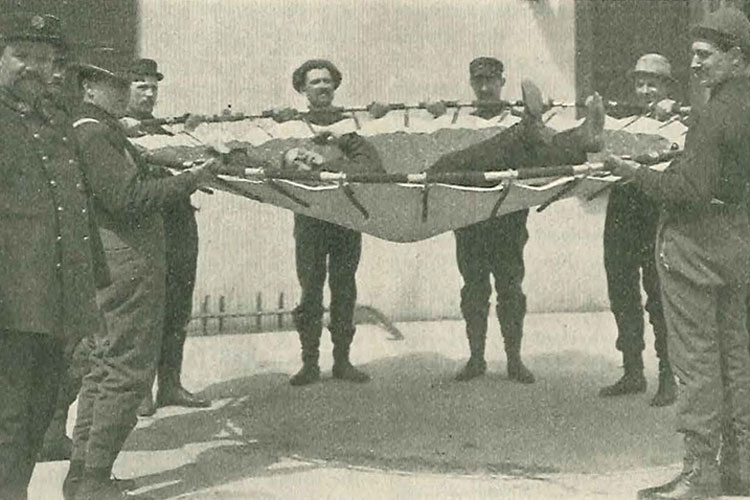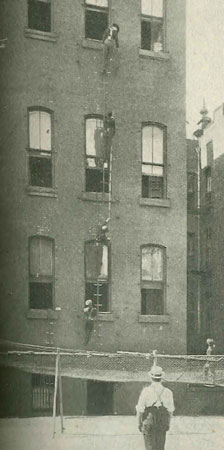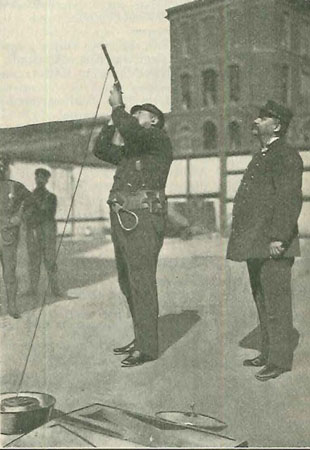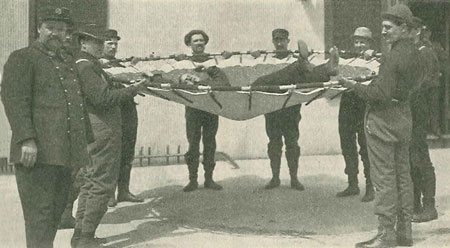
Training Firefighters, 1903: “Give Me A Chap of Ordinary Intelligence With Muscles Of Steel”
BY GLENN CORBETT
t wasn’t until the late 19th century that the concept of firefighter training became reality. Until that point, learning the art of firefighting was purely an on-the-job task. In this month’s 140th anniversary installment, we take a look back to this period, the very beginning of our fire academies. Take note of a few details that resonate today: the fire academy’s role in introducing new technology-in this case, the pompier scaling ladder; sharing knowledge among America’s firefighters as seen in the St. Louis (MO) Fire Department’s Chris Hoell training New York City’s firefighters, who in turn trained thousands of firefighters from across the United States; and the creation of “life-saving” techniques, leading to the creation of the life-saving corps, the rescue company of today. Tragically, Hoell would lose his life along with others in a building collapse, as Fire and Water recorded in 1887:
By the falling of a wall at a fire at St. Louis on Wednesday, the fire department of that city sustained the greatest calamity in its history. The fire, which was in a large warehouse, had been got under control, and the firemen were playing upon the ruins without a thought of danger, when suddenly the walls of the building collapsed, burying beneath them Captain Chris Hoell, known the country over as the father of the pompier service in America; Captain Barney McKernan and Firemen Frank McDonald, William Zimmermann, Mat Defore and Jacob Feldtman, besides a citizen named O’Brien. By dint of prompt and hard work by their comrades the last four were rescued alive, though badly injured, but Hoell, McDonald and McKernan were killed…. Captain Hoell was the man who drilled the first pompier companies organized in the fire departments of New York, Chicago and Milwaukee. Directly after the burning of the old Southern Hotel at St. Louis, in 1877, he organized and drilled a citizens’ life-saving pompier company in that city, and three of the members besides himself were taken into the fire department. Of these four, three have been killed at fires, and the other one was laid up a long time after a fire with injuries received there. Captain Hoell leaves a wife and several children. (Fire and Water, August 13, 1887)
To download a complete PDF of the original article, access it online at http://emberly.fireengineering.com/archives.html.
Fire and Water Engineering July 18, 1903:
How Firemen Are Trained. Former Instructor H. W. McAdam, of the New York city fire department, who has just resigned his post after twenty years’ service, was the first member of the department to hold that position, and, with the exception of four or five battalion chiefs in Brooklyn, every officer and man at present doing duty as a paid fireman has been drilled by him. That means that some 35,000 men, including former Chiefs Bonner, Shay, and Croker, Acting Chief Purroy, have graduated from his school. ln addition to these, twenty-five men have been to New York from as many different States in the Union for sixty days’ training, at the end of which period they, in their turn, have instructed the men of as many fire departments in those methods which are altogether peculiar to Instructor McAdam, who has, besides, been sought out by many commissioners from abroad and many foreign chiefs of brigades from the old world and from the Antipodes, all of whom are now training their men as they learned from him.
 |
| (1) Pompier ladder drill, Instructor McAdam in the foreground. (Photo by Fire and Water Engineering.) |
The school originated in 1882, after a disastrous fire had taken place in one of New York’s high buildings. None of the ladders could reach the flames, in consequence of which people had to drop from the window sills-many to their death-or fell back into the fierce fiery furnace behind them. The first instructor was Chris Hoell, of New Orleans [Editor’s note: Hoell, a German immigrant, was actually a member of the St. Louis (MO) Fire Department], inventor of the pompier scaling ladder, to instruct the firemen of this city in its use. Lieutenant McAdam, as the former chief instructor then was, was foreman of engine company No. 21 and one of the first set of volunteers who offered himself for training. On Hoell’s departure for New Orleans, the latter recommended him for chief instructor. He was appointed by the commissioner and retained in that capacity till the day of his resignation. His course of training is spread over sixty days, of which thirty are devoted to firefighting methods and thirty to life-saving. The success of the school has been phenomenal. Of the 35,000 men who have passed through it only five per cent have failed, and these because they lost their nerve, not because the instructor rejected them. Just so long as a man was willing to stick to practising he was kept at it, till by the end of the sixty days there was nothing in the way of climbing, leaping, and life-saving that he was not able to accomplish. The first stage in teaching is devoted to operating the scaling ladders. The men are shown how to raise the ladder to hook it on to the window sill so that it may not slip, how to climb it to fasten themselves to the top, how to pass a ladder, make connections, and go up one story higher, till at last, however high the building may be, they are able to get a chain of ladders to its top. Next comes straddling and standing on window sills, and swinging from window to window. This is followed by a course with the life-line, down which they are taught to slide alone or carrying another fireman. Dummies representing human beings are also utilised as burdens, some of them weighing as many as 100 or 175 pounds. This is probably the most difficult part of the training, as the men must learn not to drop their load when halfway down the ladder or life-line. When once proficient at this they cannot drop anyone whom they are carrying down without also falling themselves. There is not so much trouble when the person being rescued is conscious. As a rule he or she hangs on like grim death-too tightly, generally speaking. The hard part is when they are unconscious, and lie like a dead weight in the fireman’s arms. But the men have been taught a method of holding the victims of smoke and flames, by which it is impossible for them to let the persons go, no matter how difficult the descent. The fireman who has once got hold of someone to be rescued, if he acts up to his trainer’s methods, must bring his burden to the ground or else fall with it. The Bonner life-saving net is the next piece of life-saving apparatus with which they come in contact, and although it is not intended primarily for firemen, yet they are taught how to jump down into it, in order that they may at the same time learn how to hold it properly. The men jump into it one after another in turn from as high as the fourth story. It is somewhat risky, but in all these twenty years there have been only four accidents, and none of these fatal nor sufficiently serious to disable the man more than temporarily. Chief McAdam does not pretend to deny that many of the green men are frightened on first attempting to scale a high building. Yet, within four weeks after leaving the school these very men will be winning medals for bravery or having their names inscribed on the Roll of Honor for some plucky achievement. They saw what the older firemen did and soon were able to do whatever any one else did.
 |
| (2) Practising with life-line gun; McAdam at right. |
It must be remembered that as no two fires are alike in every particular, so the instructor must study the peculiarities of those at which he is present, attending to their several varying points, summing them up and explaining them to his class, and teaching the men how to behave under similar conditions. It may also be noticed that every company is drilled alike, and that no more training is bestowed on one than another. Nor must it be forgotten that while the civil service has done much for the New York city fire department, its value would be increased (former Chief McAdam holds), if more credit were “given for physical and less for mental development. At present the mental examination stands for sixty-five per cent, the physical for thirty-five. As a result, young men just out of school, with muscles untrained and unaccustomed to hard, steady work, head the list. Men who have worked all their lives, longshoremen, sailors, truckmen, and machinists, because they are not specially prepared for examination questions, find themselves at the foot. No one knows more than myself that you can’t make a good fireman out of one who is mentally weak; but every time give me a chap of ordinary intelligence with muscles of steel and a nerve tried by hard work. If they would even up the percentages-say, half and half, fifty per cent mental and fifty per cent physical, we should recruit a better class of firemen than those the civil service sends us today.’’
 |
| (3) Instructor McAdam (left) and men in jumping-net practice. (Photos 2 and 3 courtesy of the New York Tribune.) |
Fire Engineering Archives

